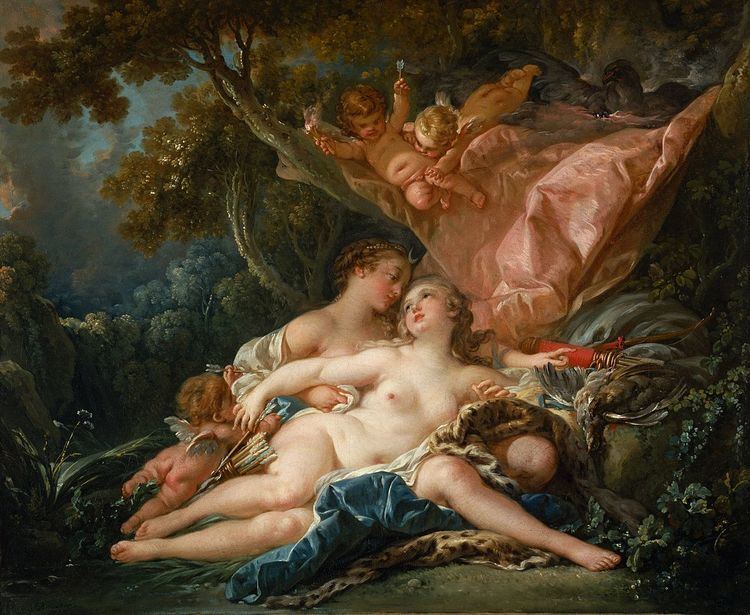 | ||
In Greek mythology, Callisto or Kallisto (/kəˈlɪstoʊ/; Greek: Καλλιστώ [kallisˈtɔː]) was a nymph, daughter of Lycaon. Transformed into a bear and set among the stars, she was the bear-mother of the Arcadians, through her son Arcas.
Contents
The fourth Galilean moon of Jupiter is named after Callisto.
Origin of the myth
The name Kalliste (Καλλίστη), "most beautiful", may be recognized as an epithet of the goddess herself, though none of the inscriptions at Athens that record priests of Artemis Kalliste (Άρτεμις Καλλίστη), date before the third century BCE. Artemis Kalliste was worshipped in Athens in a shrine which lay outside the Dipylon gate, by the side of the road to the Academy. W. S. Ferguson suggested that Artemis Soteira and Artemis Kalliste were joined in a common cult administered by a single priest. The bearlike character of Artemis herself was a feature of the Brauronia.
The myth in Catasterismi may be derived from the fact that a set of constellations appear close together in the sky, in and near the Zodiac sign of Libra, namely Ursa Minor, Ursa Major, Boötes, and Virgo. The constellation Boötes, was explicitly identified in the Hesiodic Astronomia (Αστρονομία) as Arcas, the "Bear-warden" (Arktophylax; Αρκτοφύλαξ):
He is Arkas the son of Kallisto and Zeus, and he lived in the country about Lykaion. After Zeus had seduced Kallisto, Lykaon, pretending not to know of the matter, entertained Zeus, as Hesiod says, and set before him on the table the babe [Arkas] which he had cut up.
Aeschylus' tragedy Callisto is lost.
According to Julien d'Huy, who used phylogenetic and statistical tools, the story could be a recent transformation of a Palaeolithic myth.
Myth
As a follower of Artemis, Callisto, who Hesiod said was the daughter of Lycaon, king of Arcadia, took a vow to remain a virgin, as did all the nymphs of Artemis. But to have sex with her, Zeus disguised himself as Artemis (Diana) herself, in order to lure her into his embrace. Callisto was then turned into a bear, as Hesiod had told it:
...but afterwards, when she was already with child, was seen bathing and so discovered. Upon this, the goddess was enraged and changed her into a beast. Thus she became a bear and gave birth to a son called Arcas.
Either Artemis "slew Kallisto with a shot of her silver bow," perhaps urged by the wrath of Juno (Hera) or later Arcas, the eponym of Arcadia, nearly killed his bear-mother, when she had wandered into the forbidden precinct of Zeus. In every case, Zeus placed them both in the sky as the constellations Ursa Major, called Arktos (αρκτος), the "Bear", by Greeks, and Ursa Minor.
According to Ovid, it was Jupiter (Zeus) who took the form of Diana (Artemis) so that he might evade his wife Juno’s detection, forcing himself upon Callisto while she was separated from Diana and the other nymphs. Callisto's subsequent pregnancy was discovered several months later while she was bathing with Diana and her fellow nymphs. Diana became enraged when she saw that Callisto was pregnant and expelled her from the group. Callisto later gave birth to Arcas. Juno then took the opportunity to avenge her wounded pride and transformed the nymph into a bear. Sixteen years later Callisto, still a bear, encountered her son Arcas hunting in the forest. Just as Arcas was about to kill his own mother with his javelin, Jupiter averted the tragedy by placing mother and son amongst the stars as Ursa Major and Minor, respectively. Juno, enraged that her attempt at revenge had been frustrated, appealed to Oceanus that the two might never meet his waters, thus providing a poetic explanation for their circumpolar positions.
The stars of Ursa Major were all circumpolar in Athens of 400 BCE, and all but the stars in the Great Bear's left foot were circumpolar in Ovid's Rome, in the first century CE. Now, however, due to the precession of the equinoxes, the feet of the Great Bear constellation do sink below the horizon from Rome and especially from Athens; however, Ursa Minor (Arcas) does remain completely above the horizon, even from latitudes as far south as Honolulu and Hong Kong.
